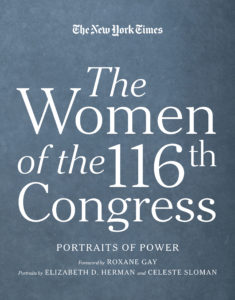For most of recorded American history, political power has looked a certain way. But the 2018 midterm elections brought a seismic change.
The Women of the 116th Congress: Portraits of Power—a collaboration between New York Times photo editors Beth Flynn and and Marisa Schwartz Taylor and photographers Elizabeth D. Herman and Celeste Sloman—documents the women of the 116th Congress, photographed in the style of historical portrait paintings commonly seen in the halls of power to highlight the stark difference between how we’ve historically viewed governance and how it has evolved.
Abraham Lincoln, the sixteenth president of the United States, painted by George Healy, and Lauren Underwood (D-IL), elected in 2018. Lincoln issued the Emancipation Proclamation in 1863, changing the legal status of slaves to free within states that had seceded from the Union; it wasn’t until more than one hundred years later, in 1968, that Shirley Chisholm (D-NY) became the first black woman elected to Congress. Underwood is the youngest black woman to ever serve in Congress and the first black woman to represent the 14th District in Lincoln’s home state of Illinois.
Kyrsten Sinema, Senator (D): Her victory in 2018 made her the first woman elected to the Senate from Arizona, the first openly bisexual person elected to the Senate, and the first woman elected to the Senate from Arizona. “It is an incredible honor to be sworn in as Arizona’s senior senator and the first woman to serve Arizona in the Senate. Arizonans deserve leaders who put country above party, and I pledge to keep our state’s tradition of doing just that.”
Deb Haaland, Representative (D): Elected in 2018, she and Sharice Davids of Kansas are the first Native American congresswomen. “Congress has never heard a voice like mine. After years of seeing my community at the whim of national politics while organizing in Indian Country, it was time for me to take the lead. I bring the perspective of New Mexicans and, for that matter, Americans in general, because I’ve been there. I’ve lived paycheck to paycheck. I’ve put a child through college. I’ve taken on student debt and still owe on my loans. These issues are not small issues for families, and there are plenty of ways we can help.”
Celeste Sloman photographs Rep. Rosa DeLauro (D-CT) on Capitol Hill on December 17, 2018; Elizabeth D. Herman photographs Speaker Pelosi (D-CA) on Capitol Hill on December 17, 2018.

The Women of the 116th Congress: Portraits of Power, by The New York Times. © October 15, 2019.





